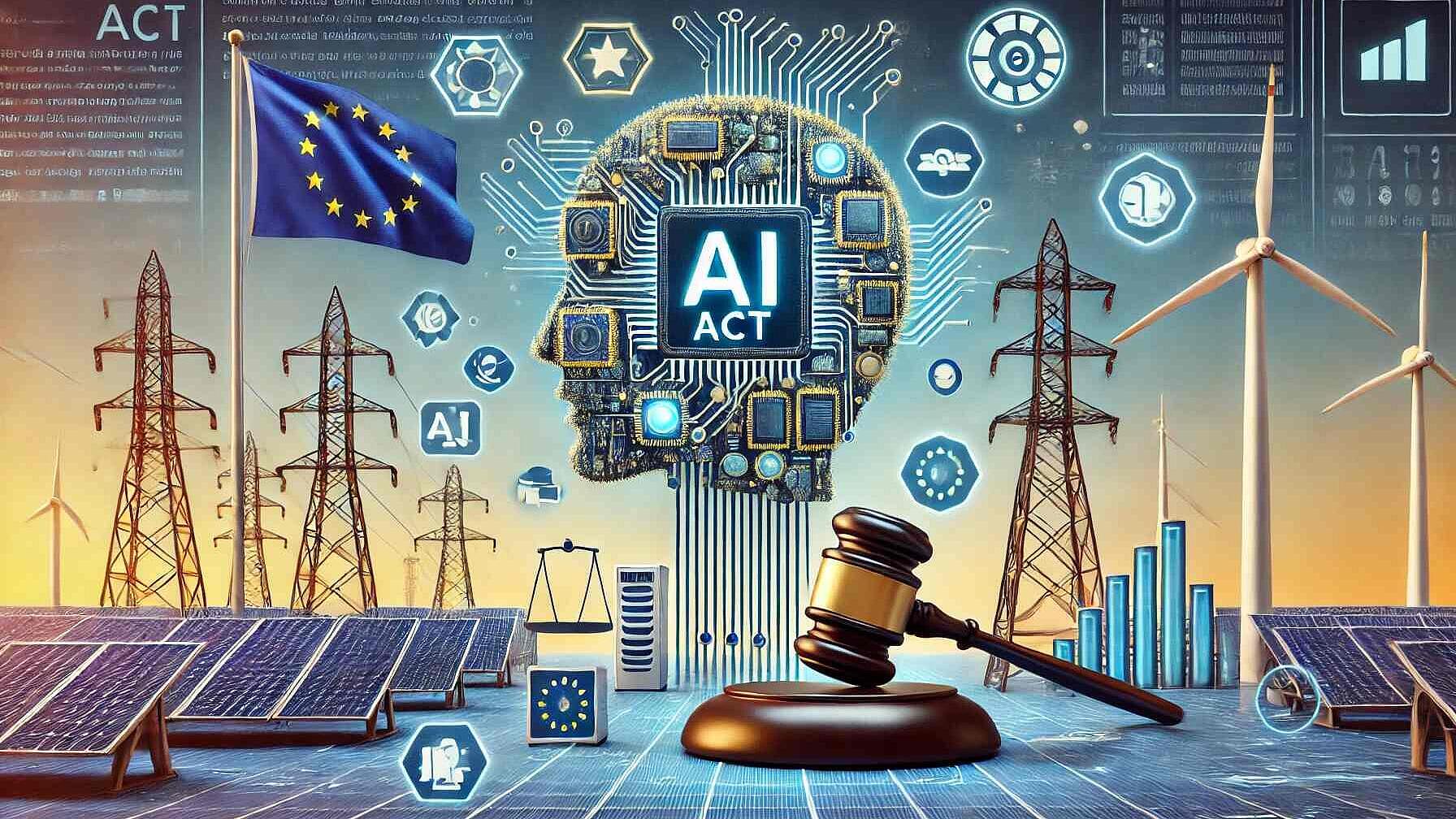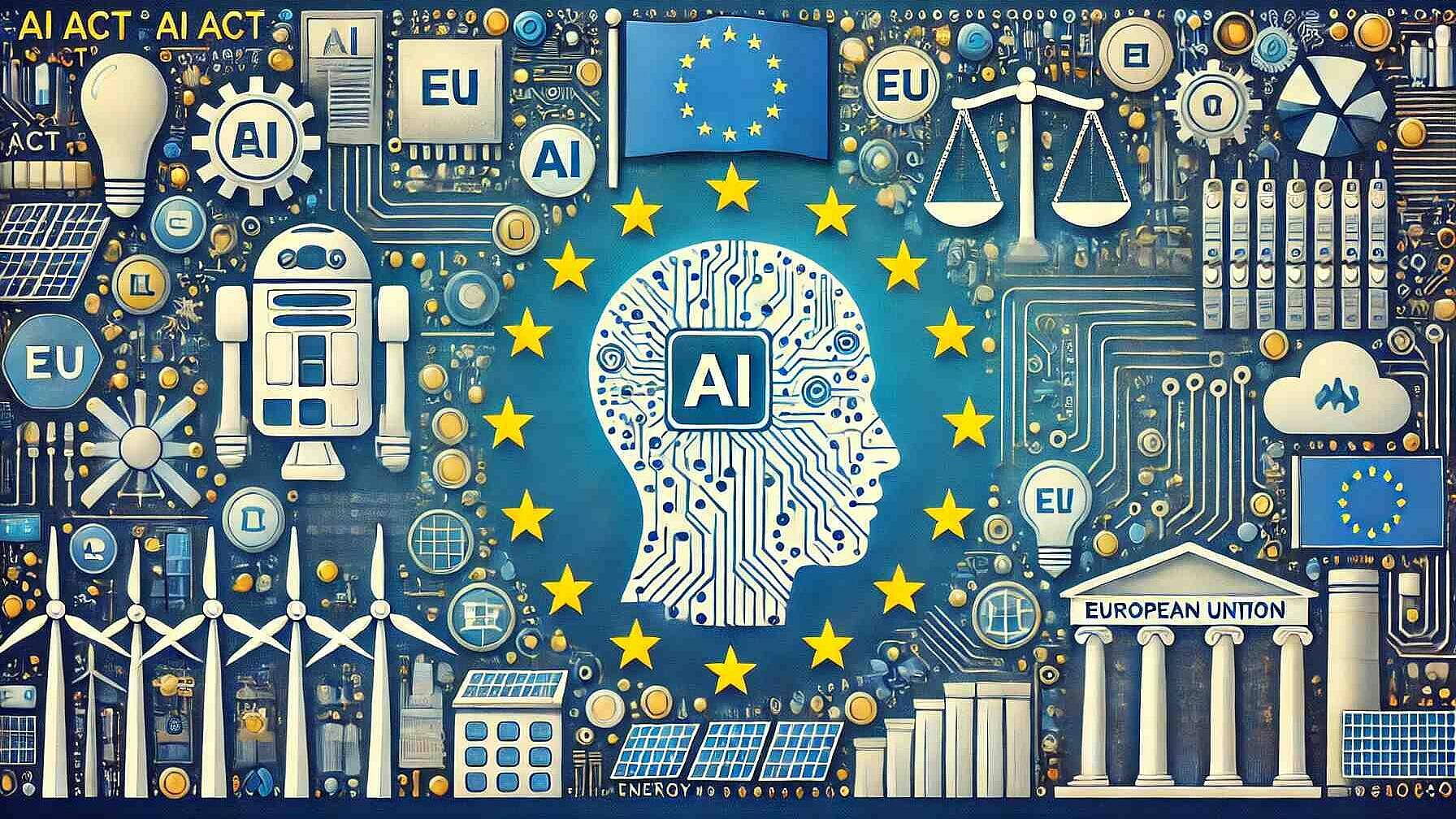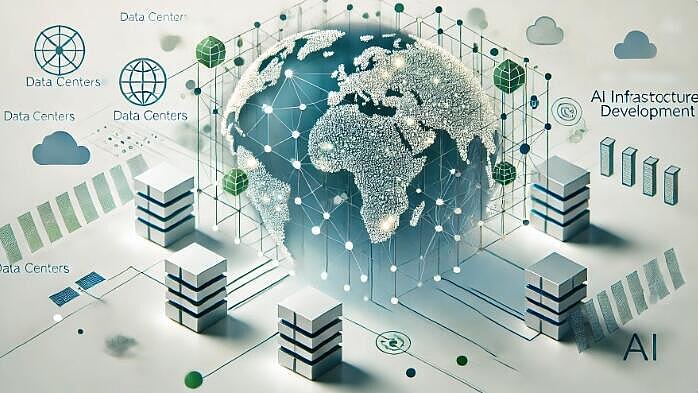 Digitalisation
DigitalisationThe AI Act: Shaping Europe's Digital Future and Transforming the Energy Sector
Summary
The EU’s Artificial Intelligence Act (AI Act) is a comprehensive legislative framework designed to regulate AI systems throughout the EU. It introduces a risk-based classification system: from unacceptable risk to minimal risk. High-risk AI systems must meet stringent requirements such as robust risk management, high-quality data, and human oversight before they enter the market. The Act has an extraterritorial impact, applying to entities outside the EU if they affect EU citizens.
To foster trustworthy AI use, the Act requires transparent operations, labeling AI interactions, and prohibits high-risk practices like social scoring and indiscriminate use of biometrics by law enforcement. Innovations and SME growth are supported through provisions like regulatory sandboxes for testing AI and specific SME support mechanisms.
The AI Act details enforcement measures, with potential penalties for non-compliance reaching €30 million or 6% of global turnover. Additionally, it offers a redress system for individuals harmed by AI systems.
The Act also has significant implications for the energy sector, where AI controls supply management and optimizes energy consumption across industries. The energy sector must ensure AI systems adhere to mandates for accuracy and data governance. Regulatory sandboxes could be instrumental in testing AI applications in energy, supporting the industry's digital transformation.
Overall, the AI Act seeks to harmonize AI regulation while promoting ethical standards and innovation, impacting various sectors, including energy, and requiring adjustments to comply with this evolving regulatory landscape.
Open full article
The AI Act: Shaping Europe's Digital Future and Transforming the Energy Sector
Here is the question: what are the main topics of the AI Act, just published in the Official Journal and thus will apply on 1st of August?
And what are top-line implications on energy sectors, both supply and demand side?
Harmonizing AI Regulation Across the EU
The Artificial Intelligence Act (AI Act) represents a landmark piece of legislation aimed at creating a unified approach to AI regulation across the European Union. At its core, the Act seeks to foster innovation while safeguarding fundamental rights and ensuring the safe development and use of AI systems.
The Act introduces a risk-based approach, categorizing AI systems based on their potential impact on society. This tiered system ranges from unacceptable risk (banned practices) to minimal risk, with corresponding obligations for developers and users. High-risk AI systems, which pose significant risks to health, safety, or fundamental rights, are subject to strict requirements before they can be placed on the market.
One of the Act's key features is its extraterritorial scope. It applies not only to providers and users within the EU but also to those outside the EU if their AI systems affect people in the EU. This broad reach aims to create a level playing field and prevent regulatory arbitrage.
The Act also establishes a governance framework, including the creation of a European Artificial Intelligence Board to facilitate consistent application of the regulation. Member States are required to designate competent national authorities to supervise and enforce the rules.
Promoting Trustworthy and Ethical AI
A central aim of the AI Act is to promote the development and use of trustworthy and ethical AI systems. The legislation sets out key requirements for high-risk AI systems, including:
- Robust risk management systems
- High-quality training and testing data
- Detailed technical documentation
- Human oversight
- Accuracy, robustness, and cybersecurity
These requirements are designed to ensure that AI systems are reliable, transparent, and accountable. The Act also mandates that providers conduct conformity assessments before placing high-risk AI systems on the market.
Transparency is a crucial aspect of the Act. Providers must inform users when they are interacting with an AI system, particularly in cases of emotion recognition or biometric categorization. There are also specific provisions for AI-generated or manipulated content (often called "deepfakes"), requiring clear labeling.
The Act prohibits certain AI practices considered to pose unacceptable risks, such as social scoring by public authorities or the use of 'real-time' remote biometric identification systems in publicly accessible spaces for law enforcement purposes (with some narrow exceptions).
Fostering Innovation and SME Growth
While the AI Act introduces significant regulatory requirements, it also aims to foster innovation and support small and medium-sized enterprises (SMEs) in the AI sector. The Act includes several provisions to this end:
- Regulatory sandboxes: Member States are required to establish AI regulatory sandboxes to facilitate the development and testing of innovative AI systems under relaxed regulatory requirements before they are placed on the market.
- Support for SMEs: The Act mandates that Member States take specific actions to support SMEs and startups, including providing priority access to AI regulatory sandboxes and offering targeted information and guidance.
- Codes of conduct: The Act encourages the development of codes of conduct for voluntary application of the requirements to non-high-risk AI systems, which can help smaller companies implement best practices.
- Standardization: The Act promotes the development of harmonized standards, which can simplify compliance processes, especially for smaller companies.
These measures are designed to ensure that the regulatory framework does not stifle innovation or create insurmountable barriers for smaller players in the AI market.
Enforcement and Penalties
To ensure compliance with its provisions, the AI Act establishes a robust enforcement mechanism. Member States are required to designate one or more competent authorities to supervise the application and implementation of the regulation.
The Act provides for significant penalties for non-compliance. Fines can reach up to €30 million or 6% of global annual turnover (whichever is higher) for the most serious infringements, such as the use of prohibited AI practices. Lesser violations can result in fines of up to €20 million or 4% of global annual turnover.
The Act also establishes a system for market surveillance, giving authorities the power to access all necessary documentation and information, including source code in certain circumstances. There are provisions for the withdrawal of non-compliant AI systems from the market.
Importantly, the Act provides for individual and collective redress, allowing persons who have suffered harm from an AI system to seek compensation.
AI in Energy
The AI Act's impact extends far beyond the tech sector, with significant implications for the energy industry. As the energy sector undergoes a digital transformation, AI is playing an increasingly crucial role in both supply and demand-side management.
On the supply side, AI has the potential to revolutionize energy generation, transmission, and distribution. According to the International Energy Agency (IEA), AI can enhance the prediction of energy supply from renewable sources, optimize grid operations, and improve maintenance schedules for energy infrastructure. For instance, AI algorithms can analyze weather patterns to forecast solar and wind energy production, allowing for more efficient integration of renewables into the grid.
The AI Act's requirements for high-risk AI systems could apply to many of these applications, particularly those involved in managing critical infrastructure. Energy companies will need to ensure their AI systems meet the Act's standards for accuracy, robustness, and cybersecurity. While this may increase compliance costs, it could also lead to more reliable and trustworthy AI systems in the energy sector.
On the demand side, AI is transforming energy consumption patterns in industry, buildings, and transport. Smart building systems use AI to optimize energy use, while industrial processes leverage AI for energy-efficient production. In the transport sector, AI is crucial for the development of electric vehicle charging infrastructure and optimizing fleet management.
The IEA highlights that AI-powered energy management systems in buildings could reduce energy use by up to 10% with no major hardware investments. In industry, AI can optimize processes to reduce energy consumption by 5-15%. These applications will likely be subject to the AI Act's requirements, particularly regarding data quality and transparency.
The Act's provisions on regulatory sandboxes could be particularly beneficial for energy sector innovation. They could provide a controlled environment for testing new AI applications in grid management, demand response, and energy trading.
However, the energy sector will also need to navigate the Act's data governance requirements. Many AI applications in energy rely on vast amounts of data, including potentially sensitive information about energy consumption patterns. Energy companies will need to ensure their data practices comply with the Act's stipulations on data quality, privacy, and security.
The AI Act could also accelerate the development of explainable AI in the energy sector. As decisions made by AI systems become more critical to energy infrastructure, the ability to understand and explain these decisions will be crucial. This aligns with the Act's emphasis on transparency and human oversight.
Outlook
The AI Act represents a significant step towards creating a harmonized, ethical, and innovation-friendly AI ecosystem in Europe. Its impact will be felt across all sectors, including energy, where AI has the potential to drive the transition to a more sustainable and efficient energy system. While compliance with the Act will require effort and investment, it also presents an opportunity to build trust in AI systems and unlock their full potential. As the Act moves towards implementation, stakeholders across industries should start preparing now to ensure they can navigate this new regulatory landscape effectively.
A few remarks and a request at the end...
The first idea to this post (and the second one on the same topic...) links back to a short LinkedIn post from my old friend Oliver Sueme who is Partner and Tech & Data Lawyer at Fieldfisher. And it relates obviously to our work at EEIP on Digitalisation and specifically the use of AI. It is a two-fold journey. We are sharing solutions and good practices from the supply and demand side while at the same time exploring use cases for us at EEIP.
We have recently set-up our own AI POLICY, which we see as a starting point not only for guidance but even more as a tool to identify such policy guidelines make sense in terms of trust, transpacency and privacy. And where these guidelibes are likely limiting our growth opportunities opening up the discussion to keep the guidelines as is for good reason - or change them.
One EEIP use case you may have seen already is our new mobile quiz, a fast-paced 5 questions in 45 seconds game with leaderbords and prices. We use a quiz as an engagement tool in EU project EENOVA. And here we are using AI tools in the preparation of questions linked to explanations and full articles as well as translations.
Another way of testing is this article which is the twin article to The Future of AI: Navigating the AI Act and its impact on energy transition. The content part of the article summarising the key topics of the AI Act and exploring its impact on the supply and demand side is mainly AI generated. For this article we have used ChatGPT4.o. The starting point for both was the same prompt. So I am of course eager to hear which one you think is better (and why). Please feel free to drop me a line under my email.
Sources:
- International Energy Agency/ (various)
- AI Act


